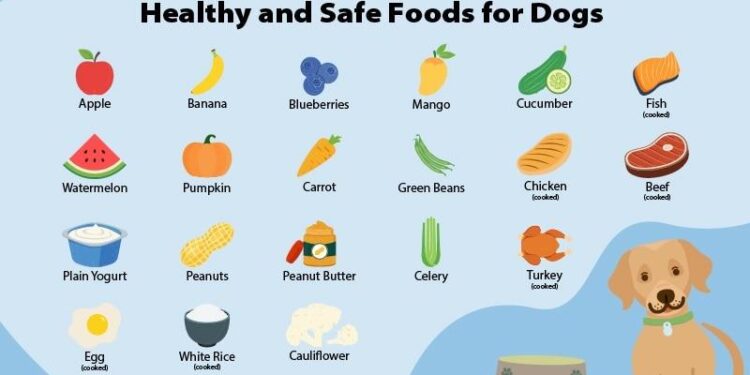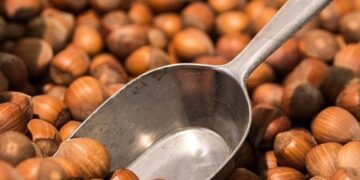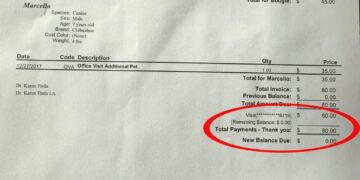Table of Contents
The Day I Realized My Expertise Was Failing My Dog
As a veterinary nutritionist, my world is built on a foundation of peer-reviewed studies, metabolic pathways, and the precise science of AAFCO nutrient profiles.
For years, I dispensed what I believed to be the gold standard of advice to my clients, and I followed it religiously for my own dog, Leo.
Leo, a magnificent Golden Retriever with a heart as golden as his coat, should have been the picture of health.
Instead, he was a case study in chronic misery.
His life was a cycle of frustrating, low-grade ailments that science struggled to solve.
There was the incessant, maddening licking of his paws, which were perpetually stained a rusty brown from his saliva.1
There were the recurring, yeasty ear infections that left him whimpering and shaking his head.3
And then there was his digestion—a volatile, unpredictable system that swung from constipation to loose stools with no discernible pattern.1
I did everything my training dictated.
Leo was on one of the most highly recommended, “premium” kibbles on the market—a brand often suggested in veterinary circles for its research and quality control.4
We ran allergy panels.
We tried hypoallergenic formulas.
We switched proteins.
Each change brought a flicker of hope, soon extinguished as the old symptoms crept back.
I was a specialist in canine nutrition whose own dog was a walking billboard for dietary failure.
The disconnect between my professional knowledge and my personal experience was a source of deep, private frustration.
I was following all the rules, yet Leo was not getting better.
It forced me to confront a terrifying question: what if the rules themselves were wrong?
This article is not just another review of dog food brands.
It is the chronicle of a journey—a journey that took me far beyond my textbooks and into the fields of microbiology and ecosystem science.
It’s the story of how I dismantled my own long-held beliefs to discover a completely new framework for understanding canine health.
It’s the story of how I stopped thinking about my dog’s body as a machine to be fueled and started seeing it as a complex, living ecosystem to be cultivated.
This paradigm shift not only resolved Leo’s chronic issues but also revealed a more profound, intuitive, and scientifically sound path to wellness that I believe can change the life of every dog.
The Epiphany: My Dog’s Gut Isn’t a Factory, It’s a Farm
My breakthrough didn’t come from a veterinary journal.
It came, unexpectedly, from a book on regenerative agriculture.6
As I read about the principles of restoring depleted farmland—minimizing soil disturbance, increasing biodiversity, keeping living roots in the ground to feed the soil’s microbiome—a powerful analogy began to form in my mind.
The authors were describing a complex, living ecosystem, a web of trillions of microorganisms working in symbiosis to create health and resilience from the ground up.8
And I realized, with a jolt, they weren’t just talking about a farm.
They were talking about what was happening inside my dog.
The canine gut is not a sterile factory, simply processing inputs (calories, protein, fat) and producing outputs (energy, waste).
It is a teeming, vibrant internal ecosystem known as the gut microbiome, populated by trillions of bacteria, fungi, and viruses.10
This microbial world is the true foundation of an animal’s health.
It governs not only digestion but also immune function—with some 70-80% of the body’s immune cells residing in the gut—and even influences mood and behavior.3
This realization led to a paradigm shift in my thinking, which I now call “Regenerative Nutrition.” It reframes the entire debate about dog food through the lens of agriculture:
- Industrial Farming (Kibble): This model represents the dominant approach to pet food. It prioritizes efficiency, shelf stability, and low cost through intense processing (like destructive soil tilling), reliance on a few monoculture crops (corn, wheat, soy), and the addition of synthetic inputs to meet minimum nutrient requirements. Over time, this approach depletes the “soil” of the gut, leading to a less diverse and less resilient internal ecosystem.
- Regenerative Farming (Fresh Food): This model mirrors the principles of regenerative agriculture. It seeks to build and nourish the gut’s “soil” by minimizing processing (no-till farming), promoting a wide variety of whole-food ingredients (polyculture), and providing the natural, high-moisture environment in which the microbiome can thrive.
The fundamental flaw in how we’ve traditionally approached canine nutrition is that we’ve been trying to be factory managers when we should have been farmers.
We’ve been focused on the “Guaranteed Analysis” on the bag—the percentages of protein, fat, and fiber—as if we were simply fueling a machine.15
But this mechanical view misses the biological reality.
The
form of the food, the quality of its ingredients, and the way it’s processed have a profound impact on the living ecosystem within.
The goal is not merely to fuel the dog but to cultivate the microbiome that, in turn, nourishes the dog from the inside O.T. This explains why two diets with nearly identical nutritional panels can produce wildly different health outcomes.
One is depleting the farm; the other is regenerating it.
Pillar 1: The Principle of Minimal Disturbance (Why Kibble is Plowing the Field)
The first principle of regenerative agriculture is to minimize soil disturbance, to protect the delicate structure and life within it.7
Yet, the standard manufacturing process for kibble is an act of extreme, violent disturbance.
It’s called extrusion, and it is the nutritional equivalent of deep, destructive plowing.
During extrusion, a slurry of ingredients is subjected to immense heat (often over 300 degrees Celsius) and pressure, then forced through a die to create the familiar pellet shape.16
This process is incredibly effective at creating a product that is shelf-stable for months or even years, but it comes at a steep biological cost.
- Nutrient Degradation: The intense heat fundamentally alters the ingredients. Sensitive vitamins, natural enzymes, and complex proteins are denatured or destroyed.16 To compensate for this nutrient loss, manufacturers spray a coating of synthetic vitamins and minerals onto the finished pellets.21 While this allows the food to meet AAFCO’s minimum requirements on paper, the bioavailability—the body’s ability to actually absorb and use these synthetic nutrients—can be lower than that of nutrients from whole foods. It’s like tilling a field so aggressively that all the natural nutrients are lost, then trying to fix it by spraying a chemical fertilizer on top.
- Formation of Harmful Compounds: The high-heat reaction between proteins and sugars in the kibble mixture can create harmful byproducts. These include Advanced Glycation End-products (AGEs) and Heterocyclic Amines (HCAs), compounds that have been linked in human and animal studies to increased inflammation, oxidative stress, and chronic diseases like diabetes and cancer.17 One study found that dogs consuming dry food had the highest levels of urine AGEs compared to those on other diets.22
In stark contrast, the “no-till” approach of fresh food aims to preserve the nutritional integrity of the ingredients.
Methods like gentle cooking, air-drying, or freeze-drying are designed to achieve a critical goal: killing harmful pathogens like Salmonella and E.
coli while leaving the food’s natural nutrient structures as intact as possible.23
This minimal disturbance protects the delicate ecosystem of nutrients within the food itself, ensuring they are delivered to the gut in a more natural and bioavailable form.
| Feature | Industrial Nutrition (Kibble) | Regenerative Nutrition (Fresh Food) |
| Processing Method | High-heat, high-pressure extrusion (like destructive tilling) 16 | Gentle cooking, air-drying, or freeze-drying (like no-till farming) 24 |
| Ingredient Form | Highly processed “meals,” by-products, and fractionated starches 27 | Whole muscle and organ meats, fresh vegetables, and fruits 29 |
| Moisture Content | Very low (5-10%), contributing to chronic dehydration 28 | High (60-75%), supporting hydration and organ function 19 |
| Nutrient Source | Often reliant on synthetic vitamin/mineral coatings added after processing 21 | Primarily derived from whole food ingredients, preserving natural bioavailability 32 |
| Impact on Gut Ecosystem | Can promote a less diverse microbiome; high starch content may feed less beneficial bacteria 33 | Fosters a more diverse and resilient microbiome; provides varied fibers for beneficial bacteria 34 |
| Key Health Implications | Associated with inflammation (AGEs), potential for lower nutrient absorption, higher stool volume 17 | Higher digestibility, improved nutrient absorption, smaller stool volume, reduced inflammation 20 |
Pillar 2: The Principle of Biodiversity (The Problem with Monoculture Meals)
A healthy farm thrives on biodiversity—a rich mix of different plants that support a complex web of life in the soil.6
A monoculture, where the same single crop is planted over and over, exhausts the soil and becomes vulnerable to pests and disease.
When you look at a typical kibble ingredient list, you are often looking at a nutritional monoculture.
The language on the bag can be misleading.
Terms that sound appealing to humans often obscure a less savory reality.
- “Meat Meals” vs. Whole Meat: The first ingredient in many premium kibbles might be “Chicken,” but the primary source of protein is often “Chicken Meal.” A “meal” is a rendered product. Tissues from animals—which can include parts not considered fit for human consumption—are cooked at high temperatures to remove water and fat, resulting in a dry, high-protein powder.27 This is a world away from the whole, human-grade muscle and organ meats that form the foundation of fresh diets.30
- Fillers and Fractionated Ingredients: To bind the kibble pellets together and keep costs down, manufacturers rely heavily on high-starch carbohydrates. Even in “grain-free” formulas, ingredients like corn, wheat, and rice are often replaced with peas, lentils, and potatoes.18 These ingredients are often “fractionated”—split into components like “pea protein” and “pea starch”—which allows manufacturers to list a meat as the first ingredient while the bulk of the food is still made of cheap plant-based components. This is the definition of a monoculture, providing a very narrow range of nutrients to the gut microbiome.
Fresh food diets, by contrast, represent a nutritional “polyculture.” A glance at the ingredient list of a reputable fresh brand reveals a diverse array of whole foods: USDA-certified beef, turkey, or pork; vibrant vegetables like carrots, broccoli, and spinach; and fiber-rich legumes like chickpeas and lentils.29
This biodiversity doesn’t just look better; it provides a wide spectrum of different fibers, phytonutrients, and micronutrients that feed a more diverse and robust community of beneficial gut microbes, just as a polyculture of cover crops enriches the soil on a regenerative farm.8
This brings us to one of the most contentious terms in pet food: “human-grade.” Many veterinarians correctly point out that the term has a strict legal definition and that just because a human can eat it doesn’t mean it’s nutritionally optimal for a dog.44
This is true.
However, this critique often misses the more important point.
The debate over “human-grade” is a distraction from the real issue: the alarming lack of transparency and quality control permitted under the “feed-grade” designation that governs the vast majority of kibble production.
Feed-grade ingredients are those that are not fit for human consumption.
This can include meat from animals that were diseased, dying, or disabled prior to slaughter, as well as byproducts like hooves, hair, and stomach contents.28
The rendering plants that produce “meat meals” operate under a different, less stringent set of regulations than the human food supply chain.28
Therefore, the value of the “human-grade” label is not just that the carrots and beef are edible by people.
Its true value is as a proxy for a fundamentally different and more trustworthy supply chain.
When a company like The Farmer’s Dog or Ollie states that their food is made in USDA-inspected kitchens using ingredients from the human food supply, they are making a verifiable claim about their process and safety standards.26
It signifies a commitment to transparency and quality control that is simply not guaranteed in the opaque world of feed-grade manufacturing.
It’s the difference between buying your produce from a certified organic farm where you can see the fields, and buying it from an industrial processor with no traceability.
Pillar 3: The Principle of Living Soil (Nourishing the Unseen World Within)
The heart of a regenerative farm is its living soil—a dark, crumbly, sweet-smelling world teeming with life.7
This is what we must aim to create inside our dogs.
The canine gut microbiome is a complex organ in its own right, and its health dictates the health of the entire animal.
A balanced, diverse microbiome efficiently breaks down food, synthesizes essential vitamins, regulates inflammation, and forms the primary defense against pathogens.13
An imbalanced microbiome, or “dysbiosis,” is linked to a host of chronic conditions, from inflammatory bowel disease to allergies and obesity.14
The science is becoming increasingly clear: what we feed our dogs directly cultivates the composition of this internal ecosystem.
- Kibble’s Impact on the “Soil”: A diet high in processed starches and low in moisture creates an environment that can favor less desirable bacteria.33 The chronic, low-level dehydration caused by a diet of dry pellets (typically only 5-10% moisture) puts stress on the kidneys and the entire system.28 It’s like trying to grow a vibrant garden in dry, compacted clay.
- Fresh Food’s Impact on the “Soil”: Fresh, whole-food diets act like rich compost for the gut. The high moisture content (often 70-75%) aids hydration and digestion.19 The diverse fibers from real vegetables and fruits feed a wider array of beneficial bacteria. Scientific studies have confirmed this effect. One study found that switching dogs from kibble to a fresh diet led to a significant increase in beneficial bacteria from the order
Lactobacillales—the same “good guys” found in probiotics.49 Another landmark study from the University of Illinois demonstrated that fresh, human-grade diets were up to 40% more digestible than kibble.37 This higher digestibility means the dog’s body absorbs more nutrients from the food, resulting in one of the most commonly reported benefits from owners: smaller, firmer, and less odorous stools.35
This was the key to understanding Leo’s suffering.
His constant itching, yeasty ears, and digestive chaos were not separate, unrelated problems.
They were all symptoms of a depleted internal farm.
The highly processed, low-moisture, low-biodiversity kibble was creating a state of chronic inflammation and gut dysbiosis.
His body was screaming for a different kind of nourishment, one that would rebuild his “soil” from the ground up.
Navigating the New Farmland: A Critical Guide to the Best Fresh Foods
Once you adopt the “Regenerative Nutrition” mindset, the question is no longer “Which brand has the best marketing?” but “Which brand is the best farmer?” To evaluate the leading fresh food companies, I developed a framework based on the core principles of regenerative agriculture.
The Criteria for Evaluation:
- Formulation Expertise (The Farmer’s Knowledge): Who is designing the diet? The gold standard is a full-time, on-staff, board-certified veterinary nutritionist (DACVIM-Nutrition). This ensures the recipes are not just based on marketing trends but on rigorous science to be complete and balanced.23
- Ingredient Quality & Sourcing (Biodiversity & Soil Health): How transparent is the company about where its ingredients come from? Do they use whole, human-grade meats and a diverse array of fresh vegetables? This speaks to the quality of the “seeds” and “compost” being used.26
- Processing & Safety (Minimal Disturbance): How is the food prepared? Gentle cooking in USDA-inspected, human-grade facilities is the ideal. What safety protocols, like testing for pathogens, are in place?.25
- Scientific Validation (Proof of Harvest): Does the company invest its own resources in proving its food works? This includes digestibility studies, long-term feeding trials that go beyond the AAFCO minimum, and publishing research in peer-reviewed journals.37
With these criteria, we can critically assess the major players in the North American fresh food market.
In-Depth Brand Analyses
The Farmer’s Dog
The Farmer’s Dog has become one of the most recognizable names in the fresh food space, largely due to its direct-to-consumer model and heavy marketing.
Their core strength lies in personalization and adherence to high safety standards.
- Formulation Expertise: The company employs multiple on-staff, board-certified veterinary nutritionists to formulate its recipes, which are designed to be complete and balanced for all life stages.47
- Ingredient Quality & Sourcing: They use human-grade ingredients, including whole muscle and organ meats and fresh vegetables, sourced from reputable suppliers in the human food chain.25 However, they are less transparent than some competitors about the specific farms or regions where ingredients are sourced.59
- Processing & Safety: Meals are gently cooked in USDA-inspected kitchens to human-food safety standards, then flash-frozen.25 They operate a “positive release” program, meaning every batch is tested for pathogens and cleared before it can be shipped.60
- Scientific Validation: This is a significant strength. The Farmer’s Dog has conducted multiple AAFCO feeding trials—the gold standard for substantiating a food’s nutritional adequacy.55 They have also gone beyond the minimum, partnering with Cornell University for a long-term feeding study and conducting their own multi-year trials to ensure their food is safe and effective for long-term feeding.55
- Critiques: Some online reviews and anecdotal reports from veterinarians raise concerns about the high fat content in some recipes, which has been linked to cases of pancreatitis in susceptible dogs.62 Their packaging is also not resealable, which can be an inconvenience for storage.64
Ollie
Ollie is another major subscription player that competes directly with The Farmer’s Dog, offering both fresh and “baked” (a gently baked kibble alternative) options.
They emphasize ingredient quality and recipe variety.
- Formulation Expertise: Ollie works with veterinary nutritionists to formulate their recipes to AAFCO standards for all life stages.26
- Ingredient Quality & Sourcing: They use human-grade ingredients, with meat always being the first ingredient. Ingredients are sourced from the U.S. and Australia from trusted suppliers who undergo a rigorous vetting process.26
- Processing & Safety: Like their competitors, Ollie cooks its food in small batches at low temperatures in human-grade U.S. facilities. They conduct microbial testing on every batch before shipping.26
- Scientific Validation: Ollie’s website states their recipes are “science-led” and vet-formulated, but they do not publicize peer-reviewed research or feeding trials to the same extent as The Farmer’s Dog or JustFoodForDogs.26 Their focus appears more on internal data collection and algorithms to personalize meal plans.68
- Critiques: A significant number of customer complaints filed with the Better Business Bureau focus on delivery and billing issues. Common problems include food arriving thawed due to insufficient dry ice, unwanted charges after cancellation attempts, and difficulties navigating their subscription service.70
Nom Nom
Nom Nom has carved out a niche by focusing specifically on gut health and investing in scientific research to validate its impact on the microbiome.
- Formulation Expertise: Nom Nom’s recipes are formulated by their on-staff board-certified veterinary nutritionist and PhD scientists.54 The company was acquired by Mars Petcare, giving them access to the extensive research and quality control resources of a major industry player.54
- Ingredient Quality & Sourcing: They use restaurant-quality, U.S.-sourced ingredients.71 Their recipes feature whole meats and recognizable vegetables, and they offer single-protein options suitable for dogs with sensitivities.72
- Processing & Safety: Meals are prepared in their own Nashville-based, human-grade facilities in small batches.54
- Scientific Validation: This is Nom Nom’s standout feature. They have conducted and published peer-reviewed research on the digestibility of their diets and their positive impact on the canine gut microbiome.35 Their studies confirm their food is highly digestible (over 90%) and promotes the growth of beneficial bacteria.74
- Critiques: The most prominent complaints found on platforms like Reddit revolve around business practices, specifically significant and sudden price increases without adequate warning to customers.75 Some users also report issues with customer service and subscription management.76
JustFoodForDogs
JustFoodForDogs (JFFD) positions itself as the most evidence-based option in the fresh food market, with a heavy emphasis on clinical research and veterinary partnerships.
- Formulation Expertise: JFFD maintains a large team of veterinary professionals, including nutritionists, toxicologists, and dermatologists, who formulate their diets.56 They also offer a line of veterinary support diets for specific medical conditions.77
- Ingredient Quality & Sourcing: All ingredients are USDA-inspected and approved for human consumption. A unique feature is their “open kitchens,” where customers can see the food being prepared.56
- Processing & Safety: Food is gently cooked in these open-to-the-public kitchens, adhering to strict safety standards.56
- Scientific Validation: This is where JFFD truly excels. They are the only fresh food company to have conducted systematic, humane feeding trials on all of their daily recipes through independent universities, with the results published in multiple peer-reviewed journals.37 Their research has proven their diets are highly digestible, promote a healthy immune system, and result in significantly less fecal volume compared to kibble.37
- Critiques: JFFD is often one of the more expensive fresh food options.78 Their retail- and direct-shipping-focused model can be less convenient for some consumers than the automated subscription services of their competitors.
The Fresh Food Brand Report Card
| Brand | Formulation Expertise | Ingredient Quality & Transparency | Processing & Safety | Scientific Validation | Overall “Regenerative” Score |
| The Farmer’s Dog | Excellent (On-staff Board-Certified Vet Nutritionists) 57 | Very Good (Human-grade, but less sourcing detail) 58 | Excellent (USDA kitchens, pathogen testing) 25 | Excellent (Multiple AAFCO feeding trials, university research) 55 | 4.5 / 5 |
| Ollie | Very Good (Works with Vet Nutritionists) 65 | Very Good (Human-grade, vetted suppliers) 26 | Excellent (Human-grade kitchens, batch testing) 26 | Good (Science-led, but lacks published trials) 68 | 3.5 / 5 |
| Nom Nom | Excellent (On-staff Board-Certified Vet Nutritionist, Mars backing) 54 | Very Good (Restaurant-quality, U.S. sourced) 71 | Excellent (Owns and operates kitchen) 54 | Excellent (Peer-reviewed digestibility and microbiome studies) 35 | 4.5 / 5 |
| JustFoodForDogs | Elite (Large veterinary team, Rx diets) 56 | Excellent (Human-grade, open kitchens for full transparency) 77 | Excellent (Cooked in public-facing kitchens) 56 | Elite (Most extensively researched; multiple peer-reviewed publications) 37 | 5.0 / 5 |
The Financial Harvest: A Realistic Look at the Cost
There is no denying that choosing to feed fresh is a significant financial commitment.
Regenerative farming requires more investment than industrial monoculture, and the same is true for pet food.
The use of human-grade whole foods, the costs of refrigerated production and shipping, and the avoidance of cheap fillers all contribute to a higher price point.20
However, it’s crucial to frame this cost not as an expense, but as an investment.
Many owners who switch find that while their food budget increases, their veterinary bills decrease over time due to the resolution of chronic diet-related issues like allergies, skin infections, and digestive problems.16
A healthier dog is a less expensive dog in the long R.N.
| Dog Size | Average Daily Cost (Premium Kibble) | Average Daily Cost (Fresh Food) | Average Monthly Cost (Premium Kibble) | Average Monthly Cost (Fresh Food) |
| Small (15 lbs) | $0.70 – $1.50 81 | $3.00 – $5.00 81 | $21 – $45 | $90 – $150 |
| Medium (40 lbs) | $2.00 – $3.00 81 | $6.00 – $10.00 79 | $60 – $90 | $180 – $300 |
| Large (70 lbs) | $4.00 – $5.50 81 | $9.00 – $13.00+ 81 | $120 – $165 | $270 – $390+ |
Note: Costs are estimates based on 2024 pricing data and can vary significantly by brand, recipe, and subscription plan.
The Farmer’s Council: Reconciling Veterinary Wisdom with a New Harvest
As a veterinary nutritionist, I cannot ignore the valid concerns and skepticism my colleagues hold regarding the fresh food movement.
The veterinary community is trained to be cautious and evidence-based, and the rapid rise of these new brands has outpaced the slow, methodical process of long-term scientific research.
It’s essential to address these concerns head-on.
- Nutritional Inadequacy: This is perhaps the most critical concern. A poorly formulated diet, whether fresh or kibble, can cause serious harm. This is especially true for homemade diets, which studies have repeatedly shown are often deficient in key nutrients.45 This is precisely why the first criterion in evaluating any food must be the involvement of a board-certified veterinary nutritionist. Choosing a reputable commercial fresh brand that invests in this expertise mitigates this risk significantly.
- Bacterial Risk: Fresh and raw foods inherently carry a higher risk of contamination with pathogens like Salmonella and E. coli compared to shelf-stable kibble.23 This is a real risk to both the pet and the humans in the household. For this reason, I strongly advocate for gently cooked fresh diets over raw diets for the vast majority of pets. Reputable cooked brands perform rigorous pathogen testing on every batch, making them a much safer choice.26
- The Role of AAFCO: The Association of American Feed Control Officials (AAFCO) sets nutrient profiles and testing protocols for pet food.89 An “AAFCO statement” on a bag is a crucial indicator of nutritional completeness.15 However, there are two levels to this statement. “Formulated to meet AAFCO profiles” means the recipe was designed on a computer to meet the standards. The gold standard is a statement that reads, “Animal feeding tests using AAFCO procedures substantiate…” This means the food was actually fed to dogs for six months and proven to be adequate.91 For years, a weakness of fresh brands was their lack of these feeding trials. Today, leading companies like The Farmer’s Dog and JustFoodForDogs have invested in and passed these rigorous trials, closing a critical gap in their evidence base.55
The rise of fresh food is exposing an emerging schism within the veterinary world.
On one side, you have esteemed institutions like Tufts University’s Petfoodology blog, which rightfully champion the decades of research, stringent quality control, and expertise of the major, established kibble manufacturers.52
They maintain a cautious, skeptical stance toward newer brands with less long-term data, warning against marketing claims that outstrip scientific proof.95
On the other side, you have a growing number of practicing veterinarians who are witnessing profound clinical improvements in their patients who switch to fresh diets.16
They are embracing a “food as medicine” philosophy, driven by the anecdotal but powerful evidence they see every day in their exam rooms.
This creates a tension between institutional skepticism and frontline clinical observation.
The consumer is often caught in the middle, hearing conflicting advice from different experts.
The truth is that both sides have valid points.
The fresh food companies are now working to bridge this gap by funding the very research and conducting the feeding trials the traditionalists have demanded, slowly building a new foundation of evidence for a new way of feeding.
Conclusion: Harvesting Health—Leo’s Transformation and Your Path Forward
After months of research and a complete overhaul of my nutritional philosophy, I made the switch for Leo.
I chose a gently cooked, vet-formulated fresh diet that aligned with the principles of Regenerative Nutrition.
The transition was gradual, but the results were anything but.
Within weeks, the frantic paw-licking subsided.
His coat, once dull and flaky, grew in thick and glossy.
His energy levels soared, and he had the playful bounce of a puppy again.
Most importantly, his digestion stabilized completely.
The unpredictable swings vanished, replaced by the kind of perfect, consistent stools that only a dog owner can truly appreciate.
Leo’s farm had been regenerated.
The vibrant health I had been trying to create with isolated, processed inputs finally blossomed when I started nourishing the entire ecosystem within him.
His transformation is the living proof of this paradigm.
For any dog owner feeling the same frustration I did, who senses there must be a better way, this journey offers a clear path forward.
Your Actionable Blueprint to Regenerative Nutrition:
- Adopt the Mindset: The single most important step is to change your thinking. Your dog’s gut is not a machine to be fueled; it’s a farm to be cultivated. Every meal is an opportunity to either deplete or enrich their internal soil.
- Audit Your Current “Farm”: Look at the bag of food in your pantry. Is it a product of disturbance (high-heat extrusion)? Is it a monoculture (full of rendered meals and starchy fillers)? Or does it reflect biodiversity and gentle handling?
- Consult Your Vet (Intelligently): Don’t ask your vet, “Is Brand X good?” Instead, go to them armed with this framework. Ask: “I’m concerned about the effects of high-heat processing and want to improve my dog’s gut microbiome. What are your thoughts on a gently cooked diet that has passed an AAFCO feeding trial and is formulated by a board-certified veterinary nutritionist?” This elevates the conversation from brands to principles.
- Choose Your “Crops”: Use the Brand Report Card in this guide to select a fresh food company that aligns with your priorities. If you value peer-reviewed science above all, JustFoodForDogs may be your answer. If you want a balance of research and convenience, The Farmer’s Dog or Nom Nom are excellent choices.
- Transition Slowly and Observe the Harvest: Switch to the new food gradually over 7-10 days to allow your dog’s microbiome time to adapt.69 Then, watch for the signs of a thriving ecosystem: improved energy, a shinier coat, healthier skin, and smaller, firmer stools.
The journey to optimal health for our dogs is not about finding a magic pellet in a bag.
It is about recognizing that we are the stewards of a precious, living world they carry within them.
It’s about becoming a better farmer.
Works cited
- How to Tell If Your Dog Has a Food Allergy | Animal Care Center of Castle Pines, accessed August 16, 2025, https://www.animalcarectr.com/blog/how-to-tell-if-your-dog-has-a-food-allergy
- 10 Symptoms of Food Allergies in Dogs and How to Treat Them – PetFriendly Box, accessed August 16, 2025, https://petfriendlybox.com/resource-center/symptoms-of-food-allergies-in-dogs
- Understanding Food Allergies in Dogs: Symptoms, Diagnosis, and How To Help, accessed August 16, 2025, https://www.animalbiome.com/blogs/dog/understanding-food-allergies-in-dogs-symptoms-diagnosis-and-how-to-help
- What’s your favorite cooked fresh dog food brand and why? – Reddit, accessed August 16, 2025, https://www.reddit.com/r/dogs/comments/ps0sjh/whats_your_favorite_cooked_fresh_dog_food_brand/
- Genuine question, why do vets push Royal Canin or science diet so hard? : r/Pets – Reddit, accessed August 16, 2025, https://www.reddit.com/r/Pets/comments/17hlrbv/genuine_question_why_do_vets_push_royal_canin_or/
- Regenerative Agriculture – Chesapeake Bay Foundation, accessed August 16, 2025, https://www.cbf.org/issues/agriculture/regenerative-agriculture.html
- 5 Principles of Regenerative Agriculture – Groundswell, accessed August 16, 2025, https://groundswellag.com/principles-of-regenerative-agriculture/
- Six Principles of Regenerative Agriculture, Explained – Ceres Rural, accessed August 16, 2025, https://ceresrural.co.uk/insights/six-principles-of-regenerative-agriculture-explained/
- The Six Principles of Regenerative Farming: Why are they important? – AgriCaptureCO2, accessed August 16, 2025, https://agricaptureco2.eu/the-six-principles-of-regenerative-farming-why-are-they-important/
- What Is Your Gut Microbiome? – Cleveland Clinic, accessed August 16, 2025, https://my.clevelandclinic.org/health/body/25201-gut-microbiome
- www.bewellsolutions.com, accessed August 16, 2025, https://www.bewellsolutions.com/butterflies-in-your-stomach-is-a-great-example-of-the-gut-brain-connection/#:~:text=The%20gut%20microbiome%20refers%20to,water%2C%20and%20chemicals%20to%20thrive.
- Gut Health in the era of the human gut microbiota: from metaphor to biovalue – PubMed, accessed August 16, 2025, https://pubmed.ncbi.nlm.nih.gov/24610296/
- The canine gastrointestinal microbiota: early studies and research frontiers – PMC, accessed August 16, 2025, https://pmc.ncbi.nlm.nih.gov/articles/PMC7524387/
- Current state of knowledge: the canine gastrointestinal microbiome | Animal Health Research Reviews | Cambridge Core, accessed August 16, 2025, https://www.cambridge.org/core/journals/animal-health-research-reviews/article/current-state-of-knowledge-the-canine-gastrointestinal-microbiome/2C30D11CE82C46327F7ACB0DAD7B6173
- AAFCO-Approved Pet Food: Everything You Need to Know | PetMD, accessed August 16, 2025, https://www.petmd.com/dog/nutrition/What-Is-AAFCO-and-What-Does-It-Do
- Fresh Dog Food vs. Kibble: Which Is Better for Your Dog? – Ollie Blog, accessed August 16, 2025, https://blog.myollie.com/fresh-dog-food-vs-kibble/
- Comparing Dog Food: Fresh vs. Raw vs. Kibble (2023 Guide), accessed August 16, 2025, https://dogstandards.ca/blogs/what-the-dog/comparing-dog-food-fresh-vs-raw-vs-kibble
- 7 Disadvantages of Kibble for Dogs and Cats – Furchild, accessed August 16, 2025, https://furchildpets.com/blog/7-disadvantages-of-kibble-for-dogs-and-cats
- The Hard Choice about Dry Pet Food: Comparison of Protein and Lipid Nutritional Qualities and Digestibility of Three Different Chicken-Based Formulations – PMC, accessed August 16, 2025, https://pmc.ncbi.nlm.nih.gov/articles/PMC9219525/
- Is Fresh Food Better For Dogs? Comparing Fresh vs. Dry Dog Food – Spot Pet Insurance, accessed August 16, 2025, https://spotpet.com/blog/pet-safety/is-fresh-dog-food-better
- What’s Wrong With Kibble? – Chattanooga Holistic Animal Institute, accessed August 16, 2025, https://chattanoogaholisticvet.com/2021/10/18/whats-wrong-with-kibble/
- Commercial Fresh Pet Food Diets – Today’s Veterinary Practice, accessed August 16, 2025, https://todaysveterinarypractice.com/wp-content/uploads/sites/4/2024/12/TVP-2025-0102_Commercial-Fresh-Food.pdf
- The Pros and Cons of Fresh Dog Food – PetMD, accessed August 16, 2025, https://www.petmd.com/dog/nutrition/pros-and-cons-fresh-dog-food
- Raw vs. Fresh Dog Food: Understanding the Differences – We Feed Raw, accessed August 16, 2025, https://wefeedraw.com/blog/raw-vs-fresh-dog-food
- Frequently Asked Questions | The Farmer’s Dog, accessed August 16, 2025, https://www.thefarmersdog.com/faq
- Ollie’s unmatched food safety standards, accessed August 16, 2025, https://www.myollie.com/food-safety/
- Why Fresh Dog Food Doesn’t Always Mean Fresh Ingredients – Sundays for Dogs, accessed August 16, 2025, https://sundaysfordogs.com/blog/why-fresh-food-doesn-t-always-mean-fresh-ingredients
- 6 issues with kibble you need to know – Healthy Active Pet, accessed August 16, 2025, https://healthyactivepet.com/blogs/pet-health-and-nutrition-4/6-issues-with-kibble-you-need-to-know
- Fresh vs Raw Dog Food vs Kibble: Which Diet Is Best For Your Dog? – American Kennel Club, accessed August 16, 2025, https://www.akc.org/expert-advice/nutrition/fresh-raw-kibble-dog-food/
- The Farmer’s Dog Ingredients and Recipes, accessed August 16, 2025, https://www.thefarmersdog.com/digest/farmers-dog-ingredients-recipes/
- The Truth About Raw Food Vs Kibble For Dogs – Oma’s Pride, accessed August 16, 2025, https://omaspride.com/blogs/articles/comparing-raw-food-vs-kibble-for-dogs
- Natural pet food: A review of natural diets and their impact on canine and feline physiology | Journal of Animal Science | Oxford Academic, accessed August 16, 2025, https://academic.oup.com/jas/article/92/9/3781/4702209
- Effects of the Dietary Protein and Carbohydrate Ratio on Gut Microbiomes in Dogs of Different Body Conditions | mBio – ASM Journals, accessed August 16, 2025, https://journals.asm.org/doi/10.1128/mbio.01703-16
- THE SCIENCE BEHIND FRESH DOG FOOD – Feed Real Institute, accessed August 16, 2025, https://www.feedreal.com/articles/the-science-behind-fresh-dog-food
- Three Newly Published Findings Support a Fresh Diet, accessed August 16, 2025, https://www.nomnomnow.com/learn/article/three-newly-published-findings-support-a-fresh-diet
- Is Fresh Food or Kibble Better for Dogs? A Comprehensive Analysis – Houndsy, accessed August 16, 2025, https://www.houndsy.com/blogs/modern-tails/is-fresh-food-or-kibble-better-for-dogs-a-comprehensive-analysis
- The Scientific Research Behind Fresh Dog Food – Just Food for Dogs, accessed August 16, 2025, https://www.justfoodfordogs.com/research.html
- What is regenerative agriculture? – Syngenta Group, accessed August 16, 2025, https://www.syngentagroup.com/regenerative-agriculture
- The Farmer’s Dog vs. The Honest Kitchen: An In-Depth Comparison, accessed August 16, 2025, https://www.thehonestkitchen.com/blogs/pet-food-ingredients/farmers-dog-vs-the-honest-kitchen
- Kibble or Human Grade Subscription Dog Food? – AKC Pet Insurance, accessed August 16, 2025, https://www.akcpetinsurance.com/blog/whats-better-for-your-dog-kibble-or-human-grade-subscription-food
- The Farmer’s Dog Ingredients: Complete 2025 Guide – Deliveryrank.com, accessed August 16, 2025, https://www.deliveryrank.com/blog/the-farmers-dog-food-ingredients
- Key Ingredients in Fresh Dog Food Explained – Ollie Blog, accessed August 16, 2025, https://blog.myollie.com/key-ingredients-in-fresh-dog-food-explained/
- Pork Potluck Dog Food | Nom Nom, accessed August 16, 2025, https://www.nomnomnow.com/meals/pork
- What Is Human-Grade Dog Food? – Union Lake Veterinary Hospital, accessed August 16, 2025, https://unionlakeveterinaryhospital.com/blog/what-is-human-grade-dog-food
- Veterinarian comments on fresh pet food versus standard pet food – Auburn OCM, accessed August 16, 2025, https://ocm.auburn.edu/experts/2019/04/151146-pet-food.php
- Is Human-Grade Dog Food Better? The Pros & Cons Explained – Dutch, accessed August 16, 2025, https://www.dutch.com/blogs/dogs/human-grade-dog-food
- The Farmer’s Dog: Human-Grade Fresh Dog Food Delivery, accessed August 16, 2025, https://www.thefarmersdog.com/
- 5 Common Dog Illnesses that are Impacted by Nutrition – PetMD, accessed August 16, 2025, https://www.petmd.com/dog/centers/nutrition/dog-diarrhea-and-other-diseases-impacted-by-nutrition
- Nom Nom & the Gut Microbiome: Making All the Difference, accessed August 16, 2025, https://www.nomnomnow.com/learn/article/nom-nom-the-gut-microbiome-making-all-the-difference
- First study on human-grade dog food says whole, fresh food is highly digestible, accessed August 16, 2025, https://aces.illinois.edu/news/first-study-human-grade-dog-food-says-whole-fresh-food-highly-digestible
- Fresh Pet Food: Fad or Future? – The Animal Medical Center, accessed August 16, 2025, https://www.amcny.org/blog/2020/01/29/fresh-pet-food-fad-or-future/
- Nutrition FAQs | Cummings School of Veterinary Medicine, accessed August 16, 2025, https://vet.tufts.edu/foster-hospital-small-animals/specialty-services/nutrition/nutrition-faqs
- Nom Nom Dog Food Review (Fresh) – Dog Food Advisor, accessed August 16, 2025, https://www.dogfoodadvisor.com/dog-food-reviews/nom-nom/
- Veterinary science behind our fresh food for pets, accessed August 16, 2025, https://www.nomnomnow.com/vet
- Does The Farmer’s Dog Do AAFCO Feeding Trials?, accessed August 16, 2025, https://www.thefarmersdog.com/digest/does-the-farmers-dog-do-aafco-feeding-trials/
- About – Veterinarian Portal | JustFoodForDogs, accessed August 16, 2025, https://vets.justfoodfordogs.com/about
- The Farmer’s Dog: Vet Team Portal Home, accessed August 16, 2025, https://vets.thefarmersdog.com/
- The Farmer’s Dog Review | Dog Food Advisor, accessed August 16, 2025, https://www.dogfoodadvisor.com/dog-food-reviews/the-farmers-dog/
- The Farmer’s Dog Inc Sustainability Report | DitchCarbon, accessed August 16, 2025, https://ditchcarbon.com/organizations/the-farmer-s-dog-inc
- The Farmer’s Dog, Inc. | BBB Reviews | Better Business Bureau, accessed August 16, 2025, https://www.bbb.org/us/ny/brooklyn/profile/online-retailer/the-farmers-dog-inc-0121-181048/customer-reviews
- How The Farmer’s Dog Meets or Exceeds the WSAVA Guidelines For Selecting Pet Food, accessed August 16, 2025, https://www.thefarmersdog.com/digest/the-farmers-dog-and-wsavas-recommendations-for-picking-a-dog-food/
- Tried Farmer’s Dog for My Pup—Now I’m Worried After Negative Reviews : r/DogFood, accessed August 16, 2025, https://www.reddit.com/r/DogFood/comments/1h73lag/tried_farmers_dog_for_my_pupnow_im_worried_after/
- Do not use Farmers Dog!! : r/DogFood – Reddit, accessed August 16, 2025, https://www.reddit.com/r/DogFood/comments/1e0d365/do_not_use_farmers_dog/
- The Best Fresh Dog Food, According To Veterinarians And Pet Owners – Forbes, accessed August 16, 2025, https://www.forbes.com/sites/forbes-personal-shopper/article/best-fresh-dog-food/
- How is Ollie made?, accessed August 16, 2025, https://www.myollie.com/faqs/?a=How-is-Ollie-made—id–dRE1XeCYQ2e0Dwb98U5tBQ
- What ingredients are used in Ollie’s dog food?, accessed August 16, 2025, https://www.myollie.com/faqs/?a=What-ingredients-are-used-in-Ollie%27s-dog-food—id–bpoFIsOMSDe5tyPr-fOrbA
- Ollie Fresh Beef & Sweet Potato Frozen Dog Food, 5 lbs. – Petco, accessed August 16, 2025, https://www.petco.com/shop/en/petcostore/product/ollie-fresh-beef-dish-with-sweet-potatoes-fresh-frozen-dog-food
- Featured Press & News – Ollie, accessed August 16, 2025, https://www.myollie.com/press/
- How much Ollie do I feed my dog?, accessed August 16, 2025, https://www.myollie.com/faqs/?a=How-much-Ollie-do-I-feed-my-dog—id–BOJmzO78SH6z8o8921rs0g
- Ollie Pets Inc. | BBB Complaints | Better Business Bureau, accessed August 16, 2025, https://www.bbb.org/us/ny/new-york/profile/pet-supplies/ollie-pets-inc-0121-171740/complaints
- Review: Nom Nom’s Fresh Food Is Simple, Clean Nutrition for Dogs – Rover.com, accessed August 16, 2025, https://www.rover.com/blog/nom-nom-review/
- Nom Nom Sampler Pack Dog Food Review 2025: An Expert’s Breakdown – Dogster, accessed August 16, 2025, https://www.dogster.com/dog-nutrition/nom-nom-sampler-pack-dog-food-review
- Nom Nom Dog Food Subscription Review 2025: Our Expert’s Breakdown – Dogster, accessed August 16, 2025, https://www.dogster.com/dog-nutrition/nom-nom-dog-food-subscription-review
- Kibble vs. Nom Nom — Who’s More Digestible?, accessed August 16, 2025, https://www.nomnomnow.com/learn/article/whos-more-digestible
- Alert for anyone using NomNomNow fresh pet food delivery: Prices …, accessed August 16, 2025, https://www.reddit.com/r/dogs/comments/venobe/alert_for_anyone_using_nomnomnow_fresh_pet_food/
- Nom Nom Fresh & Smalls = shady business practices : r/catfood – Reddit, accessed August 16, 2025, https://www.reddit.com/r/catfood/comments/qc332p/nom_nom_fresh_smalls_shady_business_practices/
- JustFoodForDogs | Fresh Dog Food, Proven Healthy, accessed August 16, 2025, https://www.justfoodfordogs.com/
- Top 5 Fresh Dog Food Brands Ranked for Quality & Nutrition (2025 Update), accessed August 16, 2025, https://spacecoastdaily.com/2025/05/top-5-fresh-dog-food-brands-ranked-for-quality-nutrition-2025-update/
- How Expensive Is Fresh Dog Food? A Comprehensive Guide to Costs, Benefits, and Alternatives | Houndsy, accessed August 16, 2025, https://www.houndsy.com/blogs/modern-tails/how-expensive-is-fresh-dog-food-a-comprehensive-guide-to-costs-benefits-and-alternatives
- Comparing Kibble vs. Raw & Fresh Foods – Tomlinson’s Feed, accessed August 16, 2025, https://tomlinsons.com/blogs/articles/comparing-kibble-vs-raw-fresh-foods
- How Much Does Dog Food Cost? – Rover.com, accessed August 16, 2025, https://www.rover.com/blog/how-much-is-dog-food/
- How Much Does Fresh Dog Food Cost? – Ollie Blog, accessed August 16, 2025, https://blog.myollie.com/how-much-does-fresh-dog-food-cost/
- Dog Food Types & Cost Comparison, accessed August 16, 2025, https://www.nomnomnow.com/learn/article/dog-food-types-cost-comparison
- Do Vets Recommend Fresh Dog Food? Understanding the Benefits and Considerations, accessed August 16, 2025, https://www.houndsy.com/blogs/modern-tails/do-vets-recommend-fresh-dog-food-understanding-the-benefits-and-considerations
- Why Do Vets HATE Homemade Dog Food? – YouTube, accessed August 16, 2025, https://www.youtube.com/watch?v=-97uO05LXfk
- Raw, Kibble, Fresh, or Cold Pressed: What’s Best for Your Dog? – Nextrition Pet, accessed August 16, 2025, https://www.nextritionpet.com/blogs/nutrition/raw-kibble-fresh-or-cold-pressed-what-s-best-for-your-dog
- Super Bowl Commercial Causes Veterinarian Rant – Truth about Pet Food, accessed August 16, 2025, https://truthaboutpetfood.com/super-bowl-commercial-causes-veterinarian-rant/
- About Pet Food Safety – CDC, accessed August 16, 2025, https://www.cdc.gov/healthy-pets/about/pet-food-safety.html
- Understanding Pet Food | AAFCO, accessed August 16, 2025, https://www.aafco.org/consumers/understanding-pet-food/
- AAFCO: Home, accessed August 16, 2025, https://www.aafco.org/
- Evaluating Pet Food – NC State Veterinary Hospital, accessed August 16, 2025, https://hospital.cvm.ncsu.edu/services/small-animals/nutrition/evaluating-pet-food/
- Pet Nutrition – Sunnyvale Veterinary Clinic, accessed August 16, 2025, https://sunnyvalevet.com/services/veterinary-nutritionist
- dog – Petfoodology – Tufts Sites, accessed August 16, 2025, https://sites.tufts.edu/petfoodology/tag/dog/
- Petfoodology – the scientific study of pet nutrition by veterinary nutrition specialists and experts. – Tufts Sites, accessed August 16, 2025, https://sites.tufts.edu/petfoodology/
- Raw Pet Foods & The Death of Expertise | The SkeptVet, accessed August 16, 2025, https://skeptvet.com/2021/01/raw-pet-foods-the-death-of-expertise/
- Why is FreshPet bad? : r/DogFood – Reddit, accessed August 16, 2025, https://www.reddit.com/r/DogFood/comments/1lcihah/why_is_freshpet_bad/






